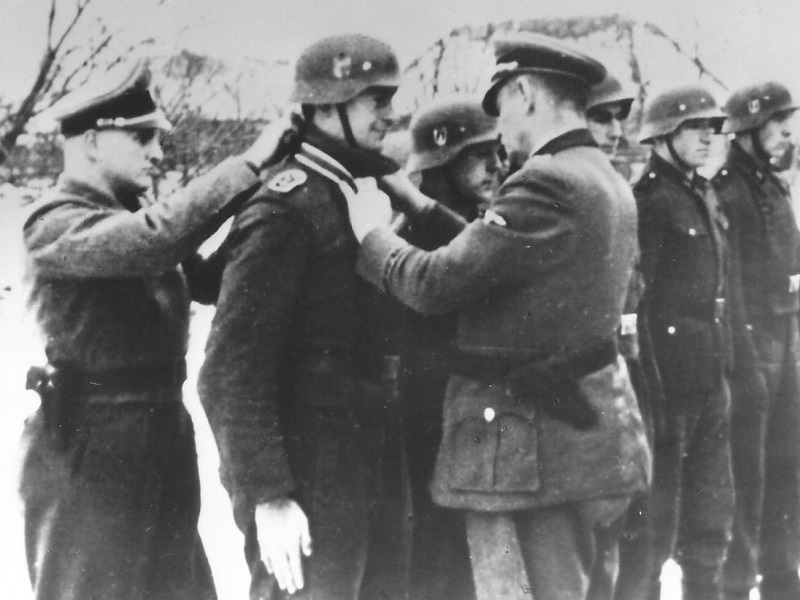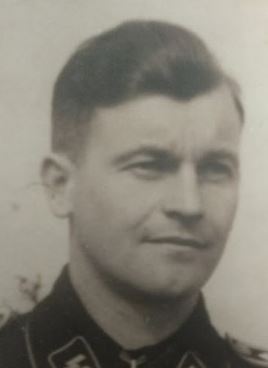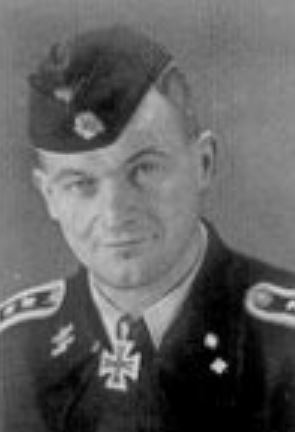Siegling, Alfred (Waffen SS)
- Date of birth:
- March 15th, 1918 (Erlau/Thuringia, Germany)
- Date of death:
- September 5th, 1984 (Röllfeld am Main/Bavaria, Germany)
- Service number:
- SS-Nr.: // NSDAP-Nr.:
- Nationality:
- German (1933-1945, Third Reich)
Biography
Alfred Siegling reached the rank of SS-Untersturmführer.
00.00.1937: joined the SS-VT, Freiwilliger, 16. Sturm, SS-Standarte 'Deutschland', Ellwangen
00.00.1938: Infanterie und Kradschützen-Lehrgang
00.09.1939: MG-Schütze, 16. Kompanie, SS-Standarte 'Der Führer', SS-VT - campaign in Poland
00.00.1940: SS-Schütze, 1. Kompanie, SS-Aufklärungs-Abteilung 'Reich', SS-VT
00.05.1940: SS-Panzerschütze, 8-rad-Panzerspähwagen, 1. Kompanie, SS-Aufklärungs-Abteilung 'Reich', SS-VT - campaign in the West
00.02.1941: SS-Rottenführer, Spähtrupp, 1. Kompanie, SS-Aufklärungs-Abteilung 'Reich', SS-VT - campaign in the Balkans
00.07.1941: SS-Oberscharführer, Spähtruppführer, 1. Kompanie, SS-Aufklärungs-Abteilung 'Reich', SS-Division 'Reich'
02.12.1943: SS-Oscha., Spähtruppführer, 1. (Panzerspäh-) Kompanie, SS-Panzer-Aufklärungs-Abteilung 2, 2. SS-Panzer-Division 'Das Reich'
09.11.1944: promoted to SS-Untersturmführer
Do you have more information about this person? Inform us!
- Period:
- Second World War (1939-1945)
- Rank:
- SS-Schütze (Private)
- Unit:
- 1. Kompanie, SS-Aufklärungs-Abteilung 'Reich', SS-VT
- Awarded on:
- August 1st, 1940
- Period:
- Second World War (1939-1945)
- Rank:
- SS- Rottenführer (Corporal)
- Period:
- Second World War (1939-1945)
- Rank:
- SS-Unterscharführer (Sergeant)
- Period:
- Second World War (1939-1945)
- Rank:
- SS-Oberscharführer (Staff Sergeant)
- Unit:
- 1. Kompanie, SS-Aufklärungs-Abteilung 2, 2. SS-Panzer-Division 'Das Reich'
- Awarded on:
- April 1st, 1943
- Period:
- Second World War (1939-1945)
- Rank:
- SS-Oberscharführer (Staff Sergeant)
- Period:
- Second World War (1939-1945)
- Rank:
- SS-Oberscharführer (Staff Sergeant)
- Unit:
- Spähtruppführer, 1. Kompanie, SS-Panzer-Aufklärungs-Abteilung "Das Reich", 2. SS-Panzer-Dvision "Das Reich", 4. Panzer-AOK, Heeresgruppe Süd
- Awarded on:
- December 2nd, 1943
"Report on the armoured troop drive by SS-Oberscharführer Alfred Siegling between 6.11-13.11.43.
On the 6.11.43 the enemy advanced with strong tank and infantry forces southwest from Kiev and moved towards the west. The main thrust of their march was towards Fastov and the 1. (Pz.Spah-Kp.) SS-Pz.Aufk. Abt. "Das Reich" was instructed to move ahead with its three armoured cars deep into the spearheads of the advancing enemy. As well as this, they were to expand deep and broad to the northwest and north to connect with our own troops in Fastov.
SS-Oberscharführer Alfred Siegling had the order to move from Pij, over Bila-Zerkwa, near Fastov and to clear up the north of there and determine the depth of the enemy penetration, as well as its composition and strength. He was also to make contact with the VII Pz.Korps.
With his light armoured cars, he started out at 11:00 hours and had almost reached Fastov by taking a dangerous route in the rear during a bold drive, reaching the city at 16:20 hours. There, Siegling came into the midst of undisciplined rear-line maintenance troops moving back from the fighting in Kiev. Siegling immediately sought out the Commander of Fastov and made contact with General von Manteuffel, the commander of the 7. Pz. Div., which had the order from the Army to defend and hold Fastov with all available equipment. Siegling was then given the order to drive to Koshanka (30km southwest of Fastov) and intercept the German tank transports there the next morning, directing them to Fastov instead.
At 18:00 hours the same day Siegling set off with his vehicles and radio car, and before 20:00 hours had arrived in Koshanka. Here Siegling met the transport group of 5 Tigers and the workshop group from the 25. Pz.Div. under the leadership of Oberleutnant von Kamecke. Siegling immediately relayed the instructions of General von Manteuffel to unload themselves and set off at once on a march towards Fastov. After hesitating for a long time, Oberleutnant von Kamecke decided to unload the vehicles. At 22:00 hours the vehicles were sent off. However, Oberleutnant von Kamecke first of all telephoned his Ia to receive instructions. He was told not to move to Fastov, but to move over Trylissy and march to the south, to the place where the mass of the 25. Pz.Div. was positioned. With a Leutnant from the 7. Pz.Div., General von Manteuffel became involved in resolving the matter of the tank transport. A long dispute followed between himself and von Kamecke over the authority of the Generals von Schell and von Manteuffel. Von Kamecke stated that General von Manteuffel was subordinated to General von Schell. Only after von Kamecke spoke to General von Manteuffel on the telephone at 03:00 hours, did he decide to march towards Fastoff himself at 02:30 hours.
Siegling arrived in Fastov only at 07:30 hours due to a flat tyre. He found that the continuous Flak front in Fastoff had been blown up some time ago and that only one Tiger could still be observed in Fastov.
In the meantime, SS-Unterscharführer Alfred Dotschel, as leader of the 2 Kompanie of the armoured car unit from Siegling, had been moved back to the town command post in Fastov and the following observations were able to be made:
On the 06.11. at 19:00 hours, the enemy stood with over fifteen T-34s and Assault Guns 7-8km eastwards of Fastov and were firing on the area of the main railway station. Fastoff offered a picture of panic and not enough officers to mount an effective defense; although they did have enough armour piercing ammunition. Among other things, marching through Fastov was an artillery Battalion (10.5cm), 7.5cm Pak and at least ten 3.7cm Pak; in addition, sixteen 88mm Flak batteries. These were assigned to stations and ordered to remain. despite the general nature of people leaving their posts. The command of the Flak was given to Oberstleutnant Kramer. On the morning of the next day, the enemy pushed forward into Fastov at 03:00 hours with at least fifteen T-34s and occupied the escape route. General von Manteuffel took it upon himself to organize resistance against this with all available equipment, however all discipline had been lost. At 05:00 hours, four T-34s advanced towards the town command post, where General von Manteuffel was. With bold determination SS-Unterscharführer Dotschel. with his armoured crews, destroyed two T-34s in close combat in front of the town command post. He was placed under fire from our own forces. Dotschel then organized resistance around the main command post. However, several T-34s surrounded this command post and placed this under close range fire. General von Manteuffel pulled himself out of Fastov and moved back towards the northwest along with the Flak, one Pioneer Kompanie and some Feldgendamerie and other stragglers. After this, Fastov was abandoned along with much of the equipment. Dotschel, with his two SS-Men were the last out of Fastoff, and in a bold drive made it out to the northwest.
The armoured car leader had in the meantime, received an order from the 7. Pz.Div. to remain behind them and to protect their right flank. During the execution of this order, Siegling succeeded in making it to Skrugilewka and again communicated with General von Manteuffel. General von Manteuffel gave the order for Siegling to drive to the Schützen Rgt. 6, which was allegedly in Brusilow. Siegling managed to catch parts of the Regiment in Kornin and moved several trucks forwards. The mass of the stragglers could be driven back to Kornin with this assistance. In one half hour the enemy tanks had already pushed forwards and occupied Skrugilewka. Siegling made his own decision to drive to Brusilow and inform the VII. Pz. Korps of the situation and his own Division. During this march, Siegling received an identical order. In the shortest possible time, Siegling succeeded and was in the foremost line with the Division "Das Reich" and the VII. Pz.Korps. In Brusilow panic prevailed. Items such as flour, raw meat and agricultural products of any kind were being taken by anyone. The civilian population was moving in amongst the German troops and hindering them. Siegling decided to use some of the soldiers to set up some temporary camps for the civilians.
On the 09.11., Siegling received the order from the Division "Das Reich" to move to the south and to communicate the constantly moving situation to the Division, which was driving back through the area of the enemy breach. Siegling moved rapidly towards Popelnja and in the evening twilight ran into some partisans. Siegling drove into the middle of Popelnja and came across enemy tanks; in a bold move he decided to break through. He first of all drove between two tanks providing security, then crept past one truck loaded with infantry and 150 m past this to seven T-70s, which had driven to the rear. With lightning speed, Siegling drove past the surprised tank crews, encountering one after another of the six T-70s on the bend and then drove off the road. As Siegling drove past the tanks, he came across an enemy car. He brought this to a halt using signs. Then a T-34 came into the middle of the road and Siegling only barely evaded this emergency on the narrow road. Subsequently, the armoured car drove past four trucks carrying infantry with two Pak guns in tow. He bluffed his way past these by continuously beeping his horn at the driver.
Driving without maps, Siegling reached Powolotsch after a night drive. Here, their armoured car came under enemy security fire, whereby the armoured car commander in the radio car was heavily wounded. Siegling decided to cross and traverse the enemy occupied town and placed their armoured car outside this location in a hay barn. With his men, Siegling marched together on foot to find a way out and they finally reached Musjewka. After Siegling had determined that one part of this place was free of the enemy, they marched further and 2km outside of there, came across partisans, with which they became involved in a short firefight with. They successfully drew themselves away from this stronger gang without loss, and after a three-hour march once again reached the armoured car. In the morning light they pushed on with their armoured car, straight towards an enemy column of trucks loaded with infantry, together with tanks and armoured cars in the rear. After a short time, they came across the damaged radio car. They recovered the wounded 2. Pz. Leader, placed him behind the anti-tank gun shield and towed the car. They drove across the most difficult of ground, driving around the edge of a swamp. The armoured car shortly faced an emergency when an enemy column drove onto the only passable road. They frequently crossed the enemy column and traversed this.
The armoured car drove 25km and reached Rushin, where he pushed against his own troops and from there reached the divisional combat group of the division "Das Reich". Siegling arrived there at 16:00 hours on the 13.11.
The armoured car of Siegling, during the time from 6-13.11, continuously breached the enemy lines, driving a total of 680 km behind them. Aware of the constant danger and the chance of capture, the success of it is thanks to Siegling. In this unique armoured car drive, he drove through the enemy and gathered the most important information about him, constantly breaking through to the west over enemy lines to report what he knew."
This recommendation was seconded by Walter Kruger, commander of the division, who wrote the following...
"I warmly approve the proposal for the award of the Knight's Cross to the Iron Cross. Through his bold, go-getting style, SS-Oberscharführer Siegling during the time 6-13.11.1943 carried out his orders, as well as executing many of his own independent decisions, and thus enabled a substantially clearer understanding of the situation. His reconnaissance conducted over many days, underlied by reliable exploitation, came out of the area around Fastov to the Division and the Korps. Thus Siegling had a part to play in the consequent well-oriented fighting leadership. His sense of duty and responsibility are examples of his enthusiasm. I hold that Siegling is particularly worthy of this high honour."
Sources
- Photo 1: Known to STIWOT
- Photo 2:
- Photo 3:
- - FELLGIEBEL, W.P., Elite of theThird Reich, Helion & Company Limited, Solihull, 2003.
- MOONEY, PETER, Waffen-SS Knights and their Battles, Schiffer Publishing, Ltd., 2012.










